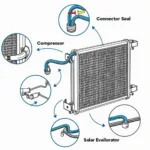Car paint repair steps involve a meticulous process to restore your vehicle’s finish. Whether you’re dealing with minor scratches, unsightly chips, or more extensive damage, understanding the correct steps can save you time and money. This guide provides a comprehensive overview of the process, from assessing the damage to achieving a professional-looking finish.
Assessing the Damage: Know Your Enemy
Before diving into car paint repair steps, carefully assess the extent of the damage. Is it a superficial scratch, a deep gouge, or perhaps bubbling paint? Identifying the type and depth of the damage will determine the appropriate repair strategy. For peeling paint, you might consider the specific steps outlined in our guide on how to repair peeling paint on a car.
A minor scratch might only require a simple polishing compound, while deeper damage may necessitate sanding, priming, and painting. Accurately assessing the damage will help you gather the right tools and materials. What seems like a small issue could indicate a larger problem, like rust, which needs immediate attention. Addressing rust early can prevent further damage and costly repairs. For more information on rust repair, check out our guide on rust patch paint repair car.
 Assessing Car Paint Damage Before Repair
Assessing Car Paint Damage Before Repair
Gathering Your Arsenal: Tools and Materials
Having the right tools and materials is crucial for successful car paint repair. This includes sandpaper of varying grits, masking tape, primer, paint that matches your car’s color, clear coat, polishing compound, and wax. For smaller scratches, a specialized scratch repair kit might be sufficient. Don’t forget essential tools like a sanding block, tack cloth, and applicators for the primer, paint, and clear coat. Investing in high-quality materials will contribute to a more durable and professional-looking finish.
For those located in Bedford, finding the right tools and materials is even easier. Visit our resource page for car paint repair bedford to locate suppliers near you.
Car Paint Repair Steps: The Process
The car paint repair process typically involves the following steps:
-
Cleaning and Preparation: Thoroughly clean the damaged area with soap and water, then degrease it with a wax and grease remover. This ensures proper adhesion of the primer and paint.
-
Sanding: Sand the damaged area with progressively finer grits of sandpaper to smooth out imperfections and create a level surface for the primer. For advice on repairing scratches, visit our guide on scratch car paint repair.
-
Masking: Use masking tape and paper to protect the surrounding areas from overspray.
-
Priming: Apply a thin, even coat of primer to the sanded area. Allow it to dry completely before proceeding.
-
Painting: Apply several thin coats of paint, allowing each coat to dry before applying the next. This ensures a smooth and even finish.
-
Clear Coat Application: Once the paint is dry, apply a few coats of clear coat to protect the paint and give it a glossy finish.
-
Polishing and Waxing: After the clear coat has cured, polish the repaired area to remove any imperfections and then wax it to protect the finish. If you’re dealing with paint bubbles, refer to our guide on how to repair car paint bubbles.
“Proper surface preparation is the key to a long-lasting and professional-looking paint repair,” says renowned automotive expert, Paul Smith, owner of Smith Auto Restoration. “Don’t rush the process, and always use high-quality materials for the best results.”
Conclusion
By following these car paint repair steps, you can effectively restore your vehicle’s finish and protect it from further damage. Remember to assess the damage accurately, gather the right tools and materials, and follow the steps meticulously for a professional-looking result. A well-maintained paint job not only enhances your car’s appearance but also protects it from the elements, preserving its value over time.
FAQ
-
How long does car paint repair take? The time required depends on the extent of the damage, but it typically takes a few hours to a full day.
-
Can I repair car paint myself? Yes, with the right tools and materials, you can repair minor paint damage yourself.
-
What type of paint should I use for car paint repair? Use automotive paint specifically designed for your car’s make and model.
-
How do I match the paint color to my car? You can find the paint code in your car’s owner’s manual or on a sticker located inside the driver’s side doorjamb.
-
How can I prevent further paint damage? Regularly washing and waxing your car can help protect the paint from the elements and prevent scratches.
“Patience and attention to detail are essential for achieving a flawless car paint repair,” adds Smith. “Take your time, follow the steps carefully, and don’t be afraid to seek professional help if needed.”
Need help with your car repair? Contact us via WhatsApp: +1(641)206-8880 or Email: cardiagtechworkshop@gmail.com. Our 24/7 customer service team is ready to assist you.


